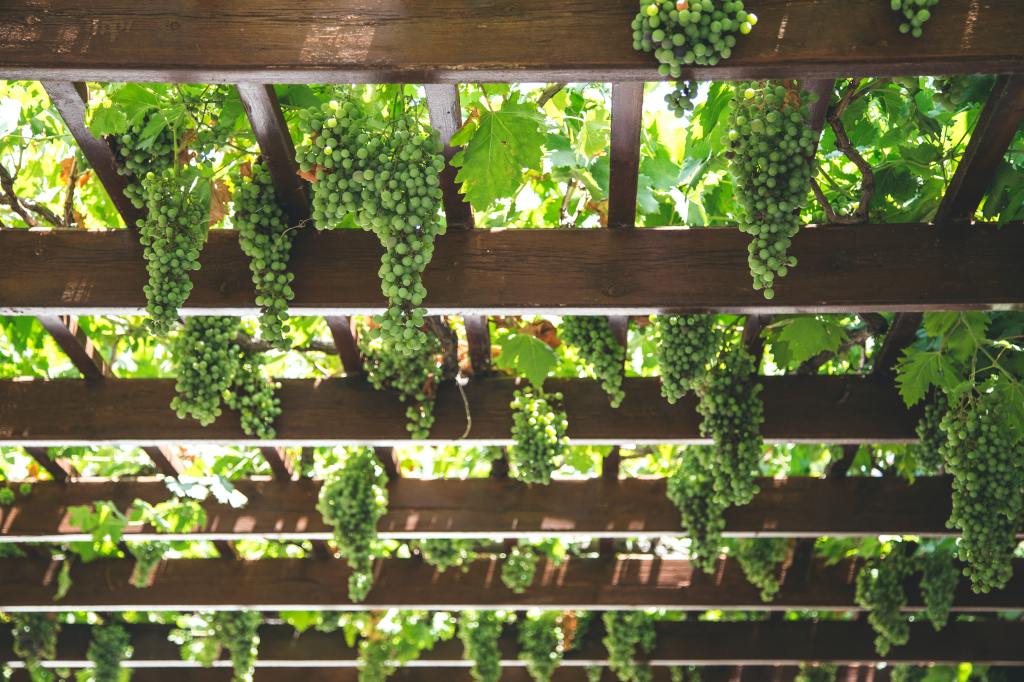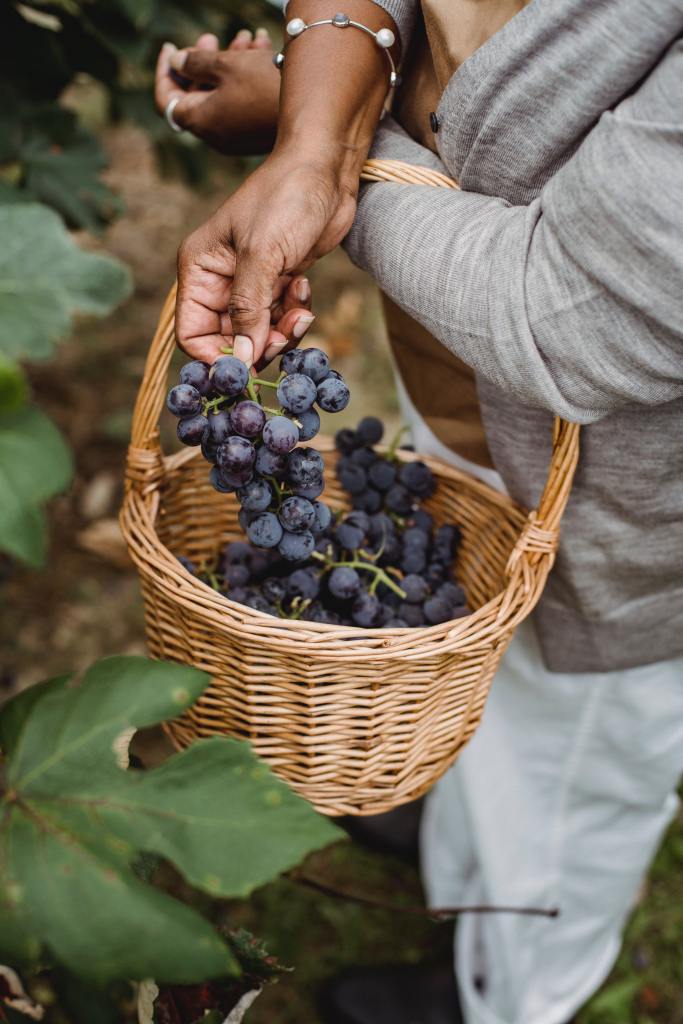“ Growing your own fruit at home is a wonderful treat and a huge money saver. Homegrown food of any kind tastes delicious and being able to go outside and pick fresh fruit from a tree is something everyone should experience.” ― Julio Belson
You may think growing grapes is for those who want to make wine. Well, that is only one of many reasons you would grow grapes. I had a beautiful grape arbor of just four vines to make my own grape juice and jellies. I never used any of them for wine, however that’s not to say you can’t.
I wanted to continue on with my Gardening 101 series with some practical guides on how to grow some of the fruits I discussed in my Top 9 Perennial Fruits and Vegetables to Grow for the Home Gardener & How to Care for Them.
So let’s get started! Today I’m going to show you how easy it is to plant your own grape arbor and to care for them!

So why bother growing grapes you ask? Well, maybe you’re someone who enjoys gardening and wants to try something new. Planting grapes and building a grape arbor can be a fun and rewarding experience. Not only will you have fresh grapes to enjoy, but you’ll also have a beautiful addition to your garden or backyard.
But how do you get started? In today’s Gardening 101, I’m going to walk you through the steps of planting grapes, building an arbor, and caring for your grapevines. From selecting the right variety of grapes to pruning and harvesting, I’ll cover everything you need to know to create a thriving grapevine. So grab your gardening gloves and let’s get started on creating your very own grape arbor.

You may also want to check out my How to Plant Asparagus and Care for it as well!
Let’s get started!

How do I decide the perfect location for my grapes?
The first step in planting grapes is selecting the perfect location. Grapevines need plenty of sunlight, good drainage, and protection from strong winds. Ideally, you should choose a spot that gets at least six hours of sunlight per day, with well-draining soil that is rich in organic matter. Avoid planting in areas that are prone to flooding or have poor drainage, as this can lead to root rot and other issues. You’ll also want to make sure the area is protected from strong winds, as this can damage the vines and reduce grape production.
When selecting the location for your grapevines, consider the size of the area you have available. Grapevines can grow quite large, so you’ll need to make sure you have enough space to accommodate them. If you’re planting more than one vine, you’ll want to space them at least six feet apart to allow for optimal growth. Keep in mind that grapevines can also be trained to climb trellises or arbors, which can help save space and create a beautiful focal point in your garden.

What’s the right grape variety for me?
There are hundreds of grape varieties to choose from, each with its own unique flavor and growing requirements. When selecting grape varieties, consider your climate, soil type, and personal taste preferences. Some popular grape varieties for home gardeners include Concord, Niagara, and Thompson Seedless. These varieties are easy to grow and produce delicious grapes that are perfect for eating fresh or making wine. I grew the Concord variety due to what I wanted to make with my grapes. Take into consideration what you are going to do with them.
If you’re looking for a specific flavor or want to grow grapes for wine-making, do your research to find the best variety for your needs. Some grape varieties are better suited for cooler climates, while others thrive in warmer temperatures. You’ll also want to consider the type of soil you have, as some grape varieties prefer sandy soils while others do better in loamy or clay soils.
Once you’ve selected your grape varieties, it’s time to prepare the soil for planting.

Now it’s time to build your grape arbor!
This photo was my grape arbor at my farm.
A grape arbor is a beautiful and functional addition to any garden or backyard. It provides support for your grapevines to climb on, as well as a shaded area to relax and enjoy your grapes. To build a grape arbor, start by selecting the right materials.
You’ll need sturdy wooden posts. I recommend using 4x4x8 pressure-treated pine posts. I used hog paneling for my grapes to grow on. They are easy to attach to the posts with U shaped nails and are heavy-duty enough to withstand the weight of the vines when weighed down with the grape clusters. You can also add decorative elements such as lattice panels or climbing plants to make your arbor even more beautiful. Metal twine also works, but it will rust quickly and evenly break in a few years. I don’t recommend the wire for anything you want long term.
PRO TIP: The key thing to remember when choosing your material for the grapes to grow on is allowance for your hand to go through the holes to harvest the grapes, as well as the grape clusters to grow through!
To build the arbor, start by digging holes for the posts at least two feet deep. Set the posts in the holes and fill with concrete to secure them in place. I use Quikrete because it dries quickly.
Once the posts are set, attach the material you chose for the grapes to grow on. If you use the metal wire, attach to the top of each post and stretch it across to the other side, securing it with nails or screws. Repeat this process until you have created a grid of wires or twine for the grapevines to climb on.

When can I plant my grape vines and how do I?
Grapevines can be planted in the spring or fall, depending on your climate and grape variety. When planting, make sure to dig a hole that is twice as wide and deep as the grapevine’s root ball. Gently loosen the roots and place the vine in the hole, making sure the soil is level with the surrounding ground. Plant each vine centered between the two posts, only one for each 6 foot section.
The vine will more than likely not be long enough to reach the bottom of your new trellis or arbor. You will need to watch, and as it grows, carefully begin training it onto the material you choose to grow your grapes on. You can use garden tape in the beginning to secure the vine onto the fencing. This will help the vine grow upward and make it easier to prune and harvest the grapes.
After planting, water your grapevines thoroughly and add a layer of mulch around the base to help retain moisture and prevent weeds. I recommend you purchase a bale of straw for each vine and spread it out evenly about 2 feet wide between each 6 foot section.

Grapevine care and maintenance
To ensure your grapevines grow and produce healthy grapes, it’s important to provide proper care and maintenance. This includes regular watering, fertilizing, pruning, and pest control.
Grapevines need regular watering, especially during hot and dry weather. Aim to water your grapevines at least once a week, giving them a deep soaking to encourage deep root growth. You can also add a layer of mulch around the base of the vines to help retain moisture and prevent weeds.
Fertilizing is also important for grapevine growth and grape production. You can use a balanced fertilizer, such as a 10-10-10 or 8-8-8 blend, and apply it in the spring and early summer. Be careful not to over-fertilize, as this can lead to excessive foliage growth and reduced grape production.
Pruning is essential for grapevine growth and grape production. In the winter, prune your grape vines by removing any dead or damaged wood, as well as any shoots that grew from the base of the plant. You’ll also want to thin out any overcrowded or crossing branches to improve air circulation and sunlight exposure. During the growing season, remove any new shoots that emerge from the base of the plant to encourage upward growth.
Finally, it’s important to protect your grapevines from pests and diseases. Common grapevine pests include aphids, spider mites, and Japanese beetles. You can use insecticidal soap or horticultural oil to control these pests, or introduce beneficial insects such as ladybugs or lacewings. To prevent diseases such as powdery mildew or black rot, make sure your grapevines have good air circulation and avoid overhead watering.
Now it’s time to harvest & enjoy your grapes!
After all your hard work, it’s time to enjoy the fruits of your labor. Grapes are typically ready to harvest in late summer or early fall, depending on the grape variety and climate. To harvest grapes, simply cut the grape clusters from the vine using a sharp pair of scissors or pruning shears.
You can enjoy your grapes fresh, or use them to make juice, jelly, or wine. There are many resources available for home winemakers, so do some research to find the best method for your needs.
PRO TIP: Your grapes will be able to endure a light frost, and being frosted will make them sweeter!
If you enjoyed this blog, please LIKE, Follow, Share & leave me a comment! I love your feedback!
If you aren’t following me on Facebook & Instagram go on over & give a LIKE & Follow me for daily tips & tricks for your home & garden!
Added bonus: You can go to my blog at http://www.fordragonfliesandme.com to purchase my original cookbook, Lovingly Seasoned Eats and Treats in either a spiral bound soft cover OR NEW, a Downloadable PDF version. The cookbook has almost 1000 recipes on almost 500 pages! Check out the Cookbook Testimonials while you’re there!
Until next time remember to,
Eat fresh, shop local & have a happy day,
Jean
Copyright Policy
All text and images on this site are copyright of For Dragonflies And Me. Unless otherwise noted, you may not use this content.












